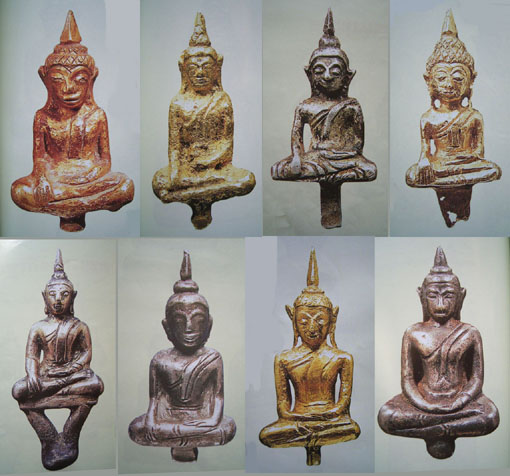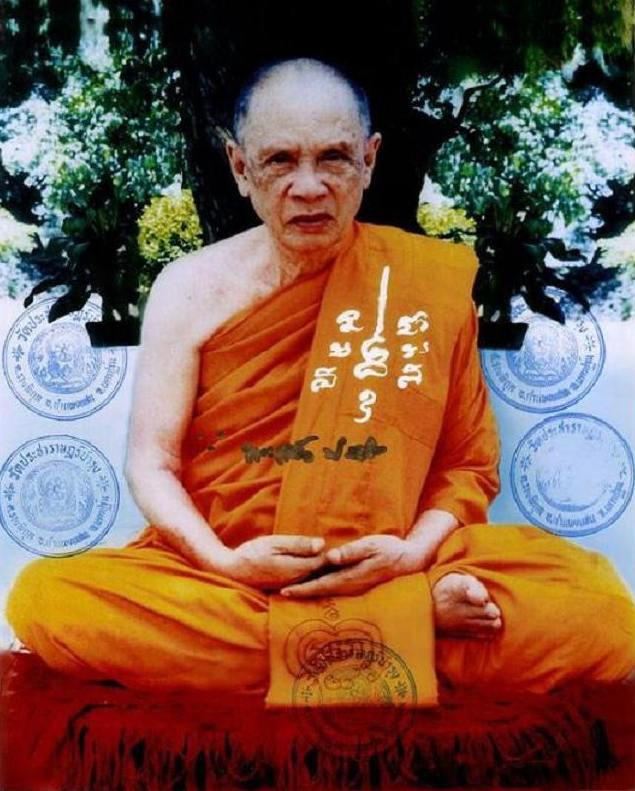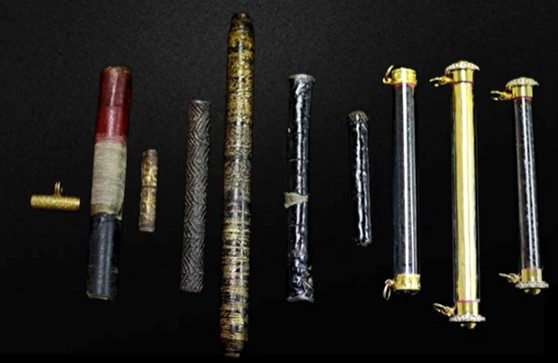Welcome to our store Uncle Chow Amulet Gallery
Archives
Biography of LP Koon Wat Banrai

LP Koon, full name Luang Pu Koon Parisutto, was born on Thursday, 4th October B.E.2466 (A.D.1923). He was raised in a well-off family but both his parents passed away when LP Koon was still young. Thereafter all his siblings, with LP Koon being the youngest, stayed with their grandfather.
His grandfather was an influential person and very well-known in the province of Nakhon Ratchasima (Korat). He was also known to possess Wichah (magic power) but unfortunately many people were afraid of him. Likewise, when L.P. Koon was a young boy, he also possessed some spiritual power. There was once a man in the village he was staying with his grandfather being possessed by a spirit and had brought fear to everyone. The brave young boy picked up a wooden stick and hit it on the possessed man’s head and got rid of the evil spirit.
The young LP Koon was taught Khmer character by his grandfather at a very young age. He is a very diligent boy and likes to study and write all those characters. These Khmer characters are very useful for magic incantation and furthermore it is also a form of village education during those days. When the young LP Koon turned 7 years old, his grandfather brought him to study Thai and Pali under Ajahn Cheum, Ajahn Saai and Phra Ajahn Lee in a temple nearby his village. n the village became familiar to this young boy’s ability.
Luang Pu Koon was then ordained as a monk at the age of 21 years old at Wat Thanon Hak Yai on 5th May B.E.2487. Phra Kru Wijahn was his preceptor. Phra Kru Archan Tong Suk was his dhamma teacher. His monk’s name was Parisutto. LP Koon stayed at Wat Thanon Hak Yai to study the dhamma scriptures. In addition, LP Koon also learned Dhamma, Samadhi (concentration meditation) and Wichah (magic) under Luang Pu Daeng from Wat Nong Poh.
Seeing that LP Koon was very diligent in learning, Luang Pu Daeng brought him to meet Luang Pu Kong whom was the abbot of Wat Hat Yai. He became a disciple of Luang Pu Kong whom is a “Dhutanga” forest tradition monk. In those days Dhutanga tradition as a way for practicing in jungles is very popular credited to the legacy of the late Venerable Phra Acharn Mun Bhuridatta Thera.
LP Koon accompanied LP Kong to various long journeys in the jungles for further studies of the dhamma and Samadhi meditation. Luang Pu Kong also taught LP Koon certain Wichah (magic) and the technique of inserting takrut into a person’s arm. After learning from Luang Pu Kong for some time, L.P. Koon went on Tudong alone. He travelled as far as Laos and Cambodia and remained in the Tiger infested forests for a period of 10 years.
There are many supernatural encounters that LP Koon experienced while he stayed alone in the thick jungles in Northern Thailand in search of the true Dhamma path. In one occasion while LP Koon was deep in meditation, he was visited by a ghostly warrior King from ancient past with a large retinue of followers. This ghost King and its entourage were once normal human beings who resided at the area where L.P. Koon was meditating. There used to be an old kingdom in the forest area but due to war, the King and his retinues were all killed and subsequently reborn into the ghost realm. They have been in the ghost realm for a very long time probably aeons. Therefore, they are seeking relief for their suffering in that woeful state.
Without any sign of fear, LP Koon through his attained meditative mind conversed with the ancient King and explained the Dhamma on the subject of impermanence (Anicca), suffering (Dukkha) and non-self (Anicca) with the aim to help the ghosts to leave that woeful state and reborn again. After hearing the Dhamma sermons and fully understood the way to escape from their suffering by detaching away their attachment to the past. Before taking leave, the ghosts paid full respect to L.P. Koon and reborn leaving their ghost realm almost immediately. To where the ghosts were reborn into the next state was not mentioned.
In another encounter, LP Koon fought off evil black magic. In the olden days living in remote villages faraway from civilization, western medication is unheard of. Most villagers will turn to witch doctors or black magicians to cure ailments and perform certain sacrificial rituals. Buddhism whereby condone all sort of animal sacrifices or killings to pleased some higher beings. Witch doctors or traditional healers are very influential in these kinds of living conditions back then. LP Koon stayed not far from that particular village surrounded by thick jungles for ease of going on alms round.
At first, many villagers were afraid to see him in yellow robe believing that it’s a bad omen and refused to give support. Later on the villagers came to know L.P. Koon is harmless and support was slowly gaining momentum. On many occasions L.P. Koon gave Dhamma sermons to the lay villagers. The witch doctor felt very uneasy with his dwindling support and influence so he thought of teaching the ascetic monk a lesson by casting black magic upon L.P. Koon. One night while L.P. Koon was in deep meditation, the witch doctor dispersed a malicious black magic to attack and cause havoc to L.P. Koon. The black magic element was a kind of “Flying Object” that had entered L.P. Koon’s stomach causing serious stomach discomfort. With relentless effort and mind power, L.P. Koon sat quietly in his meditation position trying to subdue the black magic the entire night. Finally just before sunrise, L.P. Koon managed to tame the black magic element. With Metta, he asked some questions pertaining to the black magic origin and why it came to do harm to a monk and the answer was obvious.
L.P. Koon then decided to send the black magic back to its owner – the witch doctor. Later that day around noon, the witch doctor ran frantically to ask forgiveness from L.P. Koon. He was crying in pain as his own black magic had caused tremendous stomachache just as he did earlier to L.P. Koon. With metta and after giving advice to the black magician, L.P. Koon then resided some magic spells and knocked the head of that witch doctor with a stick. Only then the black magic left the witch doctor. Soon after that, the villagers got to know the event and the more they revered the ascetic forest monk.
At one time during LP Koon’s pilgrimage at a remote place called “Buffalo Mountain” in Laos, he was visited by villagers holding guns and advised him to stay at the village instead. The villagers feared for L.P. Koon’s safety because the villagers had found tiger footprints and they were afraid that the tiger will cause injury to LP Koon. But LP Koon did not show any sign of fear. He told the villagers that “the tiger does not eat me because a tiger stays as a tiger, I stay as myself”.
The next morning LP Koon went to receive alms food at the village as usual. Later that same day, the villagers visited L.P. Koon in the forest and on their way they saw many fresh tiger footprints and reported to L.P. Koon. Anyway, L.P. Koon simply told them that “I don’t see any tiger” and subsequently he taught the villagers that “If we have loving kindness to others, others will also have loving kindness in response. Kindheartedness is a weapon of Dharma that ensure one against dangers”.
Just like many other Savaka Arahant threading on the path to enlightenment, they have to face Mara or simply known as mental defilements. L.P. Koon also faced the same challenges when he was attaining the higher stages of the Dhamma. During his final intensive meditation, he was disturbed by Mara in disguised with the form of a female dancer to distract him off the path achievement. Mara danced all night long to seduce L.P. Koon with the aim to give up the Dhamma. But with relentless effort and one-pointed mind faculty with the objective to overcome this hurdle, L.P. Koon succeeded to overcome Mara.
Upon achieving ultra Dhamma, L.P. Koon returned to Thailand and decided to reside at Wat Ban Rai at his former village sometime during the 60’s. The temple had an old Sala (shelter), Ubosot (hall) and a small Kuti. The whole temple was in a dilapidated condition. With strong determination to rebuild the temple, he approached the abbot of the temple at that time to seek help.
The then abbot of Wat Ban Rai told L.P. Koon that the temple did not have sufficient funds (only 10,000 Baht) and asked L.P. Koon how much money he would require to rebuild the temple. L.P. Koon replied that he needed 3 to 4 million Baht. The abbot had no ability to help even though it was his duty.
L.P. Koon offered to help in raising the fund needed and asked the villagers and his lay disciples to source for funds. Many people came forward and helped. The total fund collected was almost 2 million Baht and Wat Ban Rai was being rebuilt. L.P. Koon was exceptionally good in inserting takrut into a person’s arm, a technique that he had learned from Luang Pu Kong. He would personally insert the takrut under the arm of devotees.
LP Koon is very good in the Visha (supernatural arts) of inserting “Takrut ThongKum” amulet. He would personally insert the “Takrut ThongKum” under the arm of the devotees, these “Takrut ThongKum” are very well proven to protect a person from accidents, Metta (kindess) and as well as Kong Grapan (immunity from weapons). Therefore, a person who is inserted the “Takrut ThongKum” have to promise that they will not infringe the 5 Buddhist precepts. For almost 20 years L.P. Koon inserted takruts for people and all donations went into various charities and rebuilding Wat Ban Rai until today which is well known throughout Thailand and its neighboring countries.
As a result from L.P. Koon’s sheer hard work, Wat Ban Rai had been transformed from a dilapidated wooden temple into one of the biggest and richest monastery in Thailand. From that time onward, L.P. Koon gradually gained popularity in Nakhon Ratchasima. Whenever people heard L.P. Koon wanted to build a temple or school, many people would come forward to help. L.P. Koon had built many schools, temples, roads and hospitals in Nakhon Ratchasima. The devotees who go to Wat Ban Rai may be rich or poor, even so L.P. Koon will meet them personally and bless them without impartiallity due to his ultra Dhamma achievement and sincerity in helping people.
For many who possessed genuine L.P. Koon’s pendants, votive tablets and ornaments will be assured that merits are being accumulated in partaking with L.P. Koon’s good karma in massive constructions and contributions to mankind.
LP Koon’s Life Events
When comes to Thailand’s general elections, politicians all around the country vied for one man’s endorsement. He was not a billionaire, ex-president nor movie star, the man sought after was the Venerable Luang Pu Koon, a small, grandfatherly Buddhist monk with a rural accent.
Seen here is a photo of L.P. Koon conducting an incantation process to make amulets. Wat Ban Rai offers a variety of religious merchandise and good luck tokens – from stickers to blessed amulets and car ornaments. For collectors, there are just too many variety of L.P. Koon’s religious merchandise to be kept as collection. Hence, a word of advice is to stay happy with what you already have and let the mind to contented.
LP Koon also helped in amulet blessing ceremonies from other monasteries such as Wat Arun B.E.2529, Wat Mai Amataros B.E.2531 and the more recent incantation ceremony in making Phra Somdej at Wat Intharaviharn B.E.2549.
Luang Phor Khoon used to greet visitors from across the country as well as from Malaysia and Singapore from 5am to 9pm every day. On weekends, as many as 100,000 people travel to the temple to see him. Nowadays his health is deteriorating and not able to see everyone.
Donations are also a major source of income to L.P. Koon’s monastery. In Thai tradition, donations bring blessings and merits to those who give. It was estimated that L.P. Koon had brought in about USD$20 million a year in sales and donations, before the devaluation of the Thai currency during the Asian financial crisis back in 1998. Much of the money goes to charitable projects like building hospitals, schools and old-age homes. Donations appeared to have been spent on those in need and no doubt have been raised througout the years.
There are many legacies on charitable cause that L.P. Koon had performed. From schools to hospitals, old aged homes and temples. We have chosen only some photos from the many charities.
Donations are also a major source of income to L.P. Koon’s monastery. In Thai tradition, donations bring blessings and merits to those who give. It was estimated that L.P. Koon had brought in about USD$20 million a year in sales and donations, before the devaluation of the Thai currency during the Asian financial crisis back in 1998. Much of the money goes to charitable projects like building hospitals, schools and old-age homes. Donations appeared to have been spent on those in need and no doubt have been raised througout the years.
There are many legacies on charitable cause that L.P. Koon had performed. From schools to hospitals, old aged homes and temples. We have chosen only some photos from the many charities.
An example of the above early batch amulet is based on our research that dates back to a bronze pendant made in B.E.2512 by L.P. Koon. There maybe earlier made amulets that most of us haven’t come across and hopefully someday we can be enlightened by some wonderful hobbyist who is willing to share their knowledge.
Just as rescue workers lost hope, they found a hotel Housekeeping maid still alive in the rubbles. As they laboured to free the woman’s feet from beneath a concrete slab, someone threw her a pendant with L.P. Koon’s image. She prayed with it until she was freed and L.P. Koon’s magical powers made national headlines.
Even the Thai royal family has embraced L.P. Koon’s monastery after a brief conflict in 1994 when L.P. Koon’s followers started making replica banknotes with the image of the King replaced with that of the old monk. Relations were smoothed over when L.P. Koon made a generous donation to Thailand’s national welfare budget in honour of the King.
Now L.P. Koon’s followers sell these replica banknotes for donation purpose with the King’s consent and L.P. Koon receives members of the Royal family at his monastery on a regular basis.



